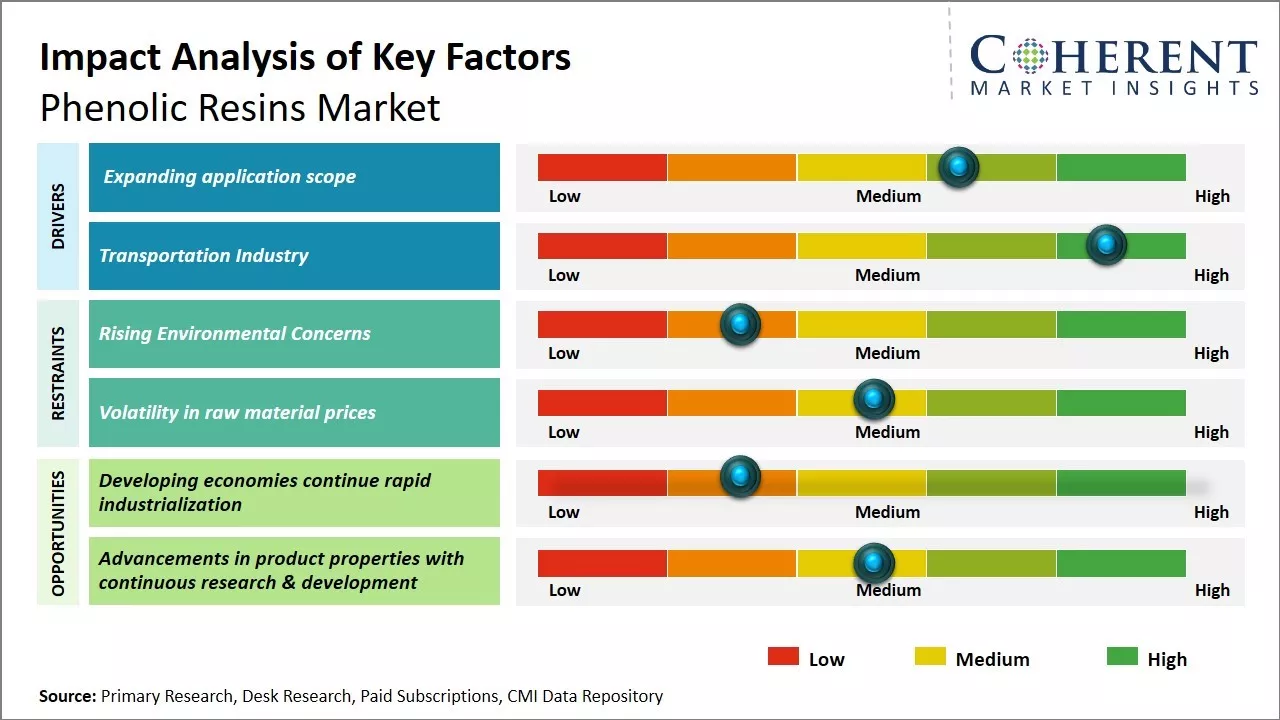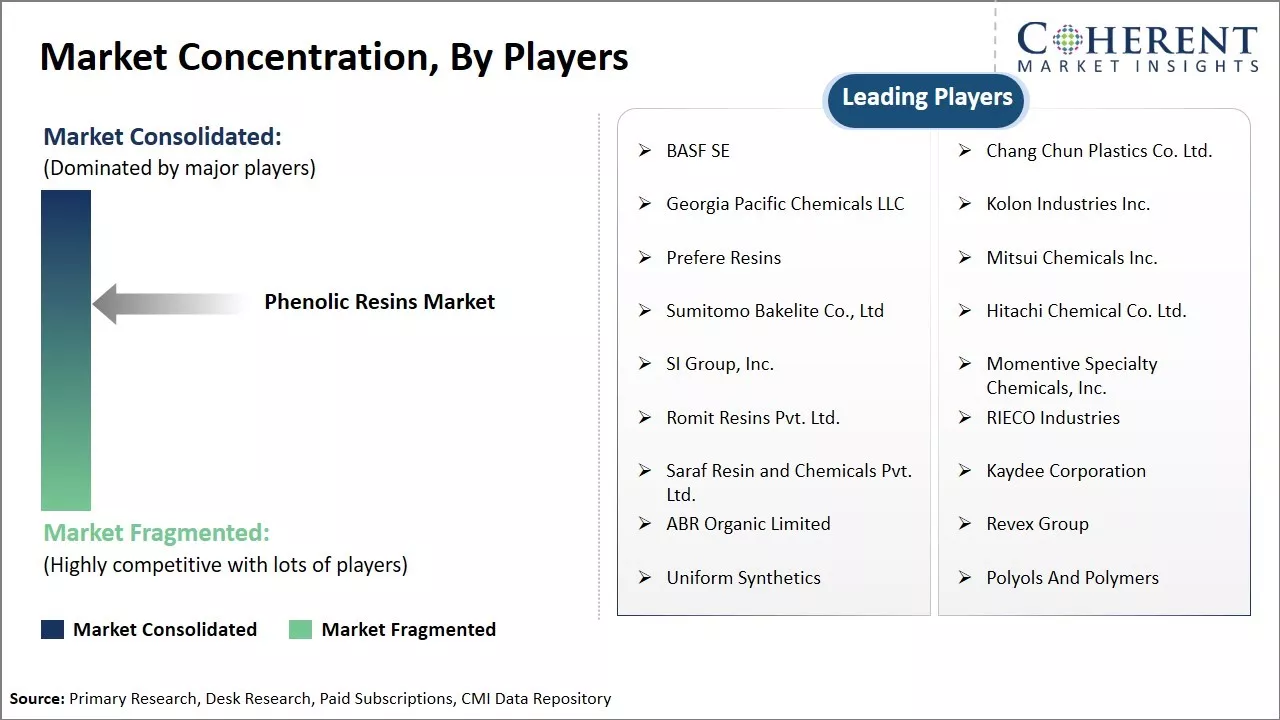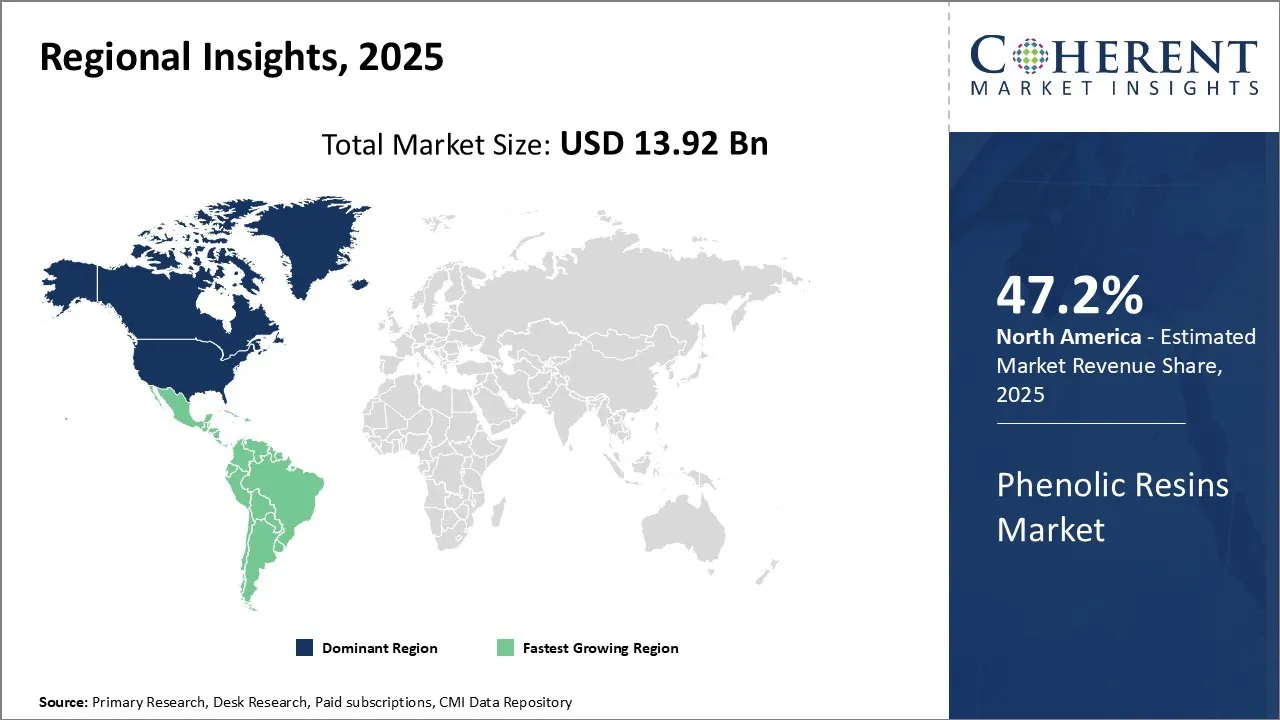The Phenolic Resins Market size is estimated to be valued at USD 13.92 Bn in 2025 and is expected to reach USD 19.09 Bn by 2032, exhibiting a compound annual growth rate (CAGR) of 4.6% from 2025 to 2032.

To learn more about this report, Download Free Sample
Laminates, molding compounds and adhesives are all applications which use phenolic resins. Because of the rising demand from the construction and building industry, this market is likely to grow steadily. Phenolic resins possess several advantages that make them useful in construction such as heat resistance, good dimensional stability, and fire resistance and are therefore used in roofing, flooring, insulation and wall paneling. Due to increased construction in Asia Pacific and Middle East Africa regions, the demand for phenolic resins is anticipated to increase during the forecast period
|
Event |
Description and Impact |
|
Regulatory Shifts in Formaldehyde Use |
|
|
Volatility in Key Raw Material Markets |
|
|
Geopolitical Trade Disruptions |
|
Uncover macros and micros vetted on 75+ parameters: Get instant access to report
The phenolic resins industry is undergoing significant technological transformation, driven by innovations in synthesis methods, sustainability efforts, and evolving application demands.
New catalytic systems, which include novel acid and alkaline catalysts, offer enhanced control over molecular weight and reduce necessary time for reactions to take place. Replace batch methods with continuous processes for better consistency and energy efficiency. Microwave techno-assisted synthesis of polymers while controlling particle size and purity with supercritical fluid technologies enhances emission reduction.
Bio-based formulations utilizing lignin phenolic derived from agriculture mitigate dependence on petroleum products Biorefineries integrated into agroforestry processes retrieve phenolic compounds yielding sustainable resins demonstrating substantial fire resistance alongside unparalleled structural stability.
Nanocomposites phenolic smart systems enable memory shape response along self-healing capabilities augmenting durability to mechanical strain do perform under aerospace automotive electronics application standards carbon nanotubes graphene oxide clay serve as nanoparticles augmenting electric thermal and structural resilience.
New formaldehyde- free hybrid polymers undergo formulated without voluminous emission microencapsulation ensuring a safe environmental workplace coupled low compliance forming robust light responsive poly-refractile shields nanobots repel matter ranging fuel low pass infra radiation turns materials ultra-fireproof for aerospace bionic construction industry
Process Control and Digital Manufacturing These days AI-based surveillance of processes, automated quality checks using spectroscopy, creation of digital twins, and other Industry 4.0 tools are being used to optimize production while reducing waste (sophisticated AI techniques can be used for these applications). The use of these technologies broadens the application spectrum of phenolic resins while making these greener and relatively more price-competitive as advanced materials which secures their utilization in mordern manufacturing.

To learn more about this report, Download Free Sample
The applications of phenolic resins have been expanding significantly over the past decade leading to rising demand. Earlier, these resins were primarily used in the wood adhesives applications, however, with advancements in material properties supported by ongoing research and development activities, their use is extending to other areas as well. The excellent heat resistance, dimensional stability and electrical properties of phenolic resins have opened up opportunities in applications such as molding compounds, friction materials, abrasion-resistant laminates and coatings.
Manufacturers have been increasingly using phenolic resins for their molding compounds in various industrial and electrical applications. The high strength and ability to withstand temperatures up to 150°C without losing properties makes phenolic resins suitable for electrical insulators and switchgear components
Also, the commendable balances of mechanical, thermal and electrical properties along with flame retardancy has boosted their acceptability in power tool components and housings of various industrial equipment. The rising demand for such industrial goods will keep driving the growth of phenolic resins market.
The transportation industry has emerged as a major end-use industry for phenolic resins with extensive applications in automotive as well as aerospace and marine sectors. Phenolic composites which provide advantages of low density, corrosion resistance and mechanical robustness are extensively utilized in the interiors of aircrafts, helicopters, ships and passenger ferry.
Ongoing innovations and introduction of light-weight flooring, ceiling, galley and lavatory components made from phenolic composites are fueling their demand from aerospace and marine industries. Moreover, in the automotive industry, strict emission regulations have induced the development and adoption of lightweight vehicles, therefore growing automotive industry is expected to drive the market growth. For instance, the automotive industry in India is the fourth-largest by production in the world as per 2022 statistics.
Developing economies continue rapid industrialization, driving demand. Additionally, innovation has yielded lower-emission resin types, allowing the market to tap applications previously unsuitable due to emissions concerns. Ongoing research aims to enhance resin properties to further broaden applications. Growth in high-performance applications could offset weakness in commodity sectors
The resole segment currently holds the 51.6% share of the phenolic resins market due to its strong bonding capabilities and resistance to heat. Novolac resins are highly durable and make excellent adhesives for uses in conditions that require high heat resistance up to 150°C. They form very hard and chemically inert thermoset polymers on curing, making them suitable for a variety of industrial applications.
Novolac resins have outstanding dielectric properties and electrical insulation qualities. They are widely used to manufacture circuit boards and electrical components. Their heat resistance allows their use in automotive and aviation engine components that experience high operating temperatures on a regular basis. Novolac resins also find major usage in fire retardant laminates and molded articles due to their flame retardant nature.
The wood adhesives application presently accounts for the 42.1% share of overall phenolic resins consumption. This is attributed to thriving end-use sectors like construction, furniture, and flooring. Phenolic resins offer excellent bonding properties for engineered wood products and other wood composite materials. Their outstanding heat resistance, water resistance and durability make phenolic resin adhesives suitable for use in flooring, plywood, laminated veneer lumber and other wood composites used extensively in the construction industry.
Phenolic resin adhesives ensure structural integrity and long service life of wood joints, floors and office furniture - qualities valued by builders, architects, and homeowners. In the booming furniture industry, phenolic resin adhesives are preferred for manufacturing high quality, long-lasting and aesthetically appealing furniture. Their ability to bind different materials such as wood, plastic and paper has supported their use in diverse modern furniture styles.
Growing construction industry is expected to drive the segment growth, For instance, growing construction industry is expected to drive the segment growth. For instance, the construction Industry in India is expected to reach USD 1.4 Trillion by 2025. The real estate industry in India is expected to reach US$ 1 Trillion by 2030 and will contribute 13% to India’s Gross domestic product

To learn more about this report, Download Free Sample
North America continues to dominate the global phenolic resins market, accounting for an estimated 47.2% share in 2025, driven by the widespread presence of mature end-use industries such as construction, automotive, and furniture. The post-2008 construction boom in the U.S. and Canada notably fueled demand for adhesives and binders derived from phenolic resins.
Environmental regulations favoring low-emission materials have accelerated the shift from formaldehyde-based to eco-friendly phenolic resins, further reinforcing their adoption across sectors. Innovation remains a regional strength, with key players launching upgraded formulations tailored to regulatory and performance demands. Additionally, robust retail and e-commerce networks, combined with proximity to Latin American and European markets, enhance the region’s competitive export position.
Asia Pacific has emerged as the fastest-growing regional market for phenolic resins, led by rapid industrialization and economic growth in China and India. China, as the world’s leading manufacturing hub, drives substantial demand for phenolic resins used in construction, electronics, and furniture manufacturing. India is following suit, with a surge in infrastructure development and expanding automotive and electrical sectors that increasingly rely on high-performance resins.
National initiatives promoting domestic manufacturing and urbanization across both nations continue to fuel market growth, positioning Asia Pacific as a strategic region for future capacity expansion and investment.
The United States holds a leading position in the global phenolic resins market, supported by its diversified industrial base and strong innovation ecosystem. The construction sector’s rebound and evolving emission norms have pushed demand for high-performance, low-toxicity phenolic solutions. American manufacturers have responded with advanced resin chemistries that cater to sustainability goals, while e-commerce and supply chain digitization enable wider market access.
China is a major growth driver in the Asia Pacific phenolic resins market, backed by its dominance in global manufacturing and exports. The country’s aggressive infrastructure rollout and capacity expansion in furniture and electronics production continue to absorb large volumes of phenolic resins. Government-backed industrial policies and R&D investments aimed at advanced materials and green manufacturing are further bolstering domestic resin consumption and technological advancement.
| Report Coverage | Details | ||
|---|---|---|---|
| Base Year: | 2024 | Market Size in 2025: | USD 13.92 Bn |
| Historical Data for: | 2020 To 2024 | Forecast Period: | 2025 To 2032 |
| Forecast Period 2025 to 2032 CAGR: | 4.6% | 2032 Value Projection: | USD 19.09 Bn |
| Geographies covered: |
|
||
| Segments covered: |
|
||
| Companies covered: |
BASF SE, Chang Chun Plastics Co. Ltd., Georgia Pacific Chemicals LLC, Kolon Industries Inc., Prefere Resins, Mitsui Chemicals Inc., Sumitomo Bakelite Co., Ltd, Hitachi Chemical Co. Ltd., SI Group, Inc., Momentive Specialty Chemicals, Inc., Romit Resins Pvt. Ltd., RIECO Industries, Saraf Resin and Chemicals Pvt. Ltd., Kaydee Corporation, ABR Organic Limited, Revex Group, Uniform Synthetics, Polyols And Polymers |
||
| Growth Drivers: |
|
||
| Restraints & Challenges: |
|
||
Uncover macros and micros vetted on 75+ parameters: Get instant access to report
Share
Share
About Author
Pankaj Poddar is a seasoned market research consultant with over 12 years of extensive experience in the fast-moving consumer goods (FMCG) and plastics material industries. He holds a Master’s degree in Business Administration with specialization in Marketing from Nirma University, one of India’s reputed institutions, which has equipped him with a solid foundation in strategic marketing and consumer behavior.
As a Senior Consultant at CMI for the past three years, he has been instrumental in harnessing his comprehensive understanding of market dynamics to provide our clients with actionable insights and strategic guidance. Throughout his career, He has developed a robust expertise in several key areas, including market estimation, competitive analysis, and the identification of emerging industry trends. His approach is grounded in a commitment to understanding client needs thoroughly and fostering collaborative relationships. His dedication to excellence and innovation solidifies his role as a trusted advisor in the ever-evolving landscape of not only FMCG but also chemicals and materials markets.
Missing comfort of reading report in your local language? Find your preferred language :
Transform your Strategy with Exclusive Trending Reports :
Frequently Asked Questions
Joining thousands of companies around the world committed to making the Excellent Business Solutions.
View All Our Clients